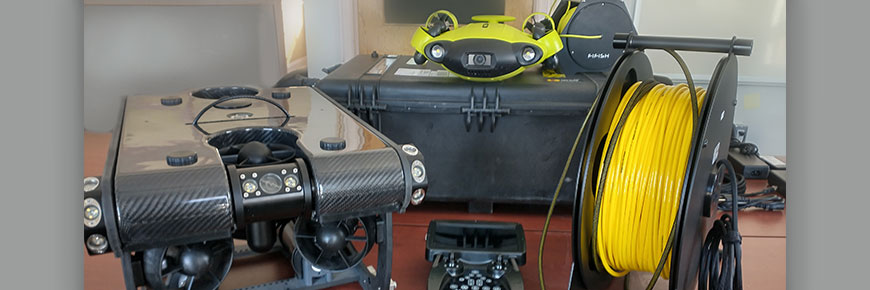
Looking for history underwater — with robots!
Lake Superior National Marine Conservation Area
By Lisa Sonnenburg and Nicole Eckert
If you visited Lake Superior National Marine Conservation Area (NMCA) this summer, you may have met our new team member, Dora. The underwater remotely operated vehicle has been helping tell the stories beneath the waves since June of 2021 — and now she’s getting help from some new ‘friends’.
For many people, underwater remotely operated vehicles (ROVs) are novel technologies that they recognize from the opening scene in the movie Titanic, from deep sea documentaries, or expedition videos. While these large and expensive vehicles are used all over the world for scientific research, there is a new generation of smaller and less expensive ROVs being used by Parks Canada at sites like Lake Superior NMCA to document and monitor submerged cultural resources.
Lake Superior NMCA purchased its first ROV in March 2021 to see how useful this tool could be for doing underwater surveys. The unit earned the name Dora, because it is a brightly coloured underwater explorer. Its light weight allows it to be carried along rocky shorelines or deployed from small boats. It is very easy to use, with a set up time of less than five minutes. In 2021, we were able to use it to monitor some of the known underwater cultural resources and assist with a few local infrastructure investigations. To top it all, Dora became the star of the very successful ‘Underwater Museum’ visitor experience program.
Dora’s underwater adventures proved the importance and versatility of this tool. So, we sought a more advanced level ROV that would be able to go into deeper waters and add additional scientific equipment, such as side-scan sonars. We sourced an ROV, from a Canadian company, that is larger and heavier, yet can still be lifted by one person, and can go as deep as 300 meters — almost to the deepest part of Lake Superior. We also realized that we needed another unit similar to Dora, as she had become very busy helping our Visitor Experience team. So now Dora has a ‘buddy,’ called Diego, that we are using alongside the bigger ROV for survey and documentation.
The results have been extraordinary. In 2022, the new ROVs inspected historic infrastructure, assisted with a shoreline cleanup, went down a mine shaft, and helped us locate and document previously unknown submerged cultural resources within the NMCA.
And in case you were wondering, the big ROV is still unnamed — so if you have some suggestions for a name, we’d love to hear them!
We are looking forward to working with the ROVs in 2023, to help us document and protect the many submerged resources within the NMCA. With over 10,000 square kilometers of water to investigate, we will continue to find innovative new ways of documenting, monitoring, and preserving the underwater cultural heritage of this amazing place, and share the stories for generations to come.
Back to shoreLINES
- Date modified :